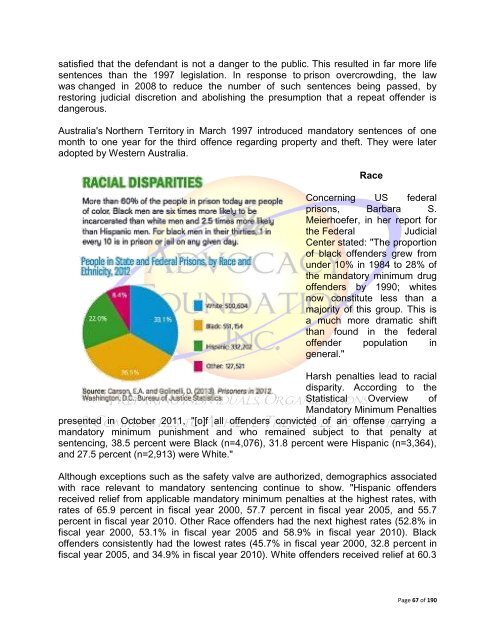The Violent Crime and Law Enforcement Act of 1994
The Violent Crime and Law Enforcement Act of 1994
The Violent Crime and Law Enforcement Act of 1994
Create successful ePaper yourself
Turn your PDF publications into a flip-book with our unique Google optimized e-Paper software.
satisfied that the defendant is not a danger to the public. This resulted in far more life<br />
sentences than the 1997 legislation. In response to prison overcrowding, the law<br />
was changed in 2008 to reduce the number <strong>of</strong> such sentences being passed, by<br />
restoring judicial discretion <strong>and</strong> abolishing the presumption that a repeat <strong>of</strong>fender is<br />
dangerous.<br />
Australia's Northern Territory in March 1997 introduced m<strong>and</strong>atory sentences <strong>of</strong> one<br />
month to one year for the third <strong>of</strong>fence regarding property <strong>and</strong> theft. <strong>The</strong>y were later<br />
adopted by Western Australia.<br />
Race<br />
Concerning US federal<br />
prisons, Barbara S.<br />
Meierhoefer, in her report for<br />
the Federal<br />
Judicial<br />
Center stated: "<strong>The</strong> proportion<br />
<strong>of</strong> black <strong>of</strong>fenders grew from<br />
under 10% in 1984 to 28% <strong>of</strong><br />
the m<strong>and</strong>atory minimum drug<br />
<strong>of</strong>fenders by 1990; whites<br />
now constitute less than a<br />
majority <strong>of</strong> this group. This is<br />
a much more dramatic shift<br />
than found in the federal<br />
<strong>of</strong>fender population in<br />
general."<br />
Harsh penalties lead to racial<br />
disparity. According to the<br />
Statistical Overview <strong>of</strong><br />
M<strong>and</strong>atory Minimum Penalties<br />
presented in October 2011, "[o]f all <strong>of</strong>fenders convicted <strong>of</strong> an <strong>of</strong>fense carrying a<br />
m<strong>and</strong>atory minimum punishment <strong>and</strong> who remained subject to that penalty at<br />
sentencing, 38.5 percent were Black (n=4,076), 31.8 percent were Hispanic (n=3,364),<br />
<strong>and</strong> 27.5 percent (n=2,913) were White."<br />
Although exceptions such as the safety valve are authorized, demographics associated<br />
with race relevant to m<strong>and</strong>atory sentencing continue to show. "Hispanic <strong>of</strong>fenders<br />
received relief from applicable m<strong>and</strong>atory minimum penalties at the highest rates, with<br />
rates <strong>of</strong> 65.9 percent in fiscal year 2000, 57.7 percent in fiscal year 2005, <strong>and</strong> 55.7<br />
percent in fiscal year 2010. Other Race <strong>of</strong>fenders had the next highest rates (52.8% in<br />
fiscal year 2000, 53.1% in fiscal year 2005 <strong>and</strong> 58.9% in fiscal year 2010). Black<br />
<strong>of</strong>fenders consistently had the lowest rates (45.7% in fiscal year 2000, 32.8 percent in<br />
fiscal year 2005, <strong>and</strong> 34.9% in fiscal year 2010). White <strong>of</strong>fenders received relief at 60.3<br />
Page 67 <strong>of</strong> 190
















